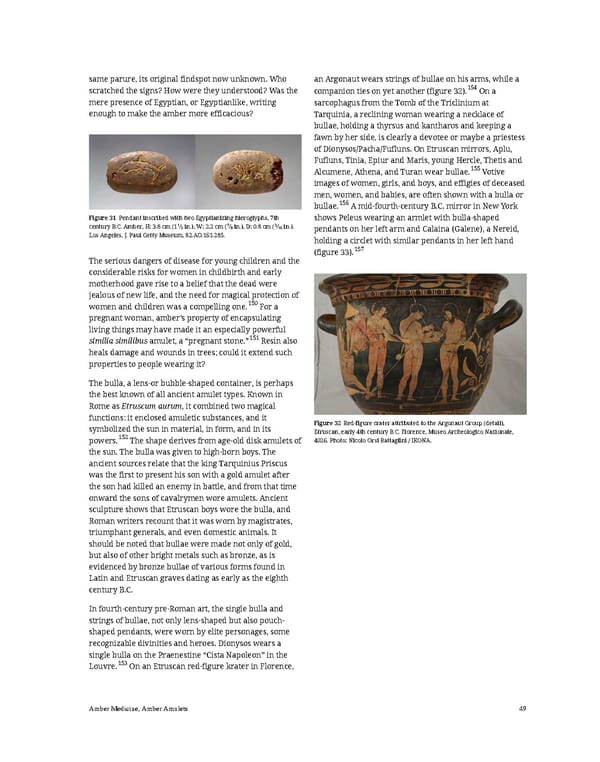same parure, its original findspot now unknown. Who an Argonaut wears strings of bullae on his arms, while a scratched the signs? How were they understood? Was the companion ties on yet another (figure 32).154 On a mere presence of Egyptian, or Egyptianlike, writing sarcophagus from the Tomb of the Triclinium at enough to make the amber more efficacious? Tarquinia, a reclining woman wearing a necklace of bullae, holding a thyrsus and kantharos and keeping a fawn by her side, is clearly a devotee or maybe a priestess of Dionysos/Pacha/Fufluns. On Etruscan mirrors, Aplu, Fufluns, Tinia, Epiur and Maris, young Hercle, Thetis and Alcumene, Athena, and Turan wear bullae.155 Votive images of women, girls, and boys, and effigies of deceased men, women, and babies, are often shown with a bulla or bullae.156 A mid-fourth-century B.C. mirror in New York Figure 31 Pendant inscribed with two Egyptianizing hieroglyphs, 7th shows Peleus wearing an armlet with bulla-shaped century B.C. Amber, H: 3.8 cm (11⁄2 in.), W: 2.2 cm (7⁄8 in.), D: 0.8 cm (3⁄10 in.). pendants on her left arm and Calaina (Galene), a Nereid, Los Angeles, J. Paul Getty Museum, 82.AO.161.285. holding a circlet with similar pendants in her left hand (figure 33).157 The serious dangers of disease for young children and the considerable risks for women in childbirth and early motherhood gave rise to a belief that the dead were jealous of new life, and the need for magical protection of women and children was a compelling one.150 For a pregnant woman, amber’s property of encapsulating living things may have made it an especially powerful similia similibus amulet, a “pregnant stone.”151 Resin also heals damage and wounds in trees; could it extend such properties to people wearing it? The bulla, a lens-or bubble-shaped container, is perhaps the best known of all ancient amulet types. Known in Rome asEtruscum aurum, it combined two magical functions: it enclosed amuletic substances, and it Figure 32 Red-figure crater attributed to the Argonaut Group (detail), symbolized the sun in material, in form, and in its Etruscan, early 4th century B.C. Florence, Museo Archeologico Nazionale, powers.152 The shape derives from age-old disk amulets of 4026. Photo: Nicolo Orsi Battaglini / IKONA. the sun. The bulla was given to high-born boys. The ancient sources relate that the king Tarquinius Priscus was the first to present his son with a gold amulet after the son had killed an enemy in battle, and from that time onward the sons of cavalrymen wore amulets. Ancient sculpture shows that Etruscan boys wore the bulla, and Roman writers recount that it was worn by magistrates, triumphant generals, and even domestic animals. It should be noted that bullae were made not only of gold, but also of other bright metals such as bronze, as is evidenced by bronze bullae of various forms found in Latin and Etruscan graves dating as early as the eighth century B.C. In fourth-century pre-Roman art, the single bulla and strings of bullae, not only lens-shaped but also pouch- shaped pendants, were worn by elite personages, some recognizable divinities and heroes. Dionysos wears a single bulla on the Praenestine “Cista Napoleon” in the Louvre.153 On an Etruscan red-figure krater in Florence, Amber Medicine, Amber Amulets 49
 Ancient Carved Ambers in the J. Paul Getty Museum Page 58 Page 60
Ancient Carved Ambers in the J. Paul Getty Museum Page 58 Page 60